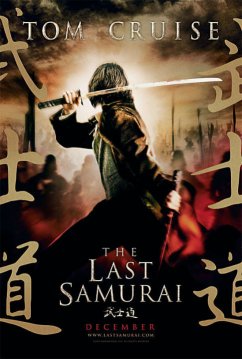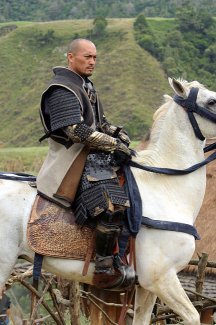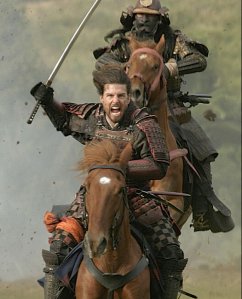|
The Last
Samurai
Let us pretend
that The Last Samurai takes in some fantastical historical
otherworld. Clearly, that's the only way it's going to work.
To tie
it into real history is too disturbing. Not only does Tom
Cruise "regain his honor" by betraying his country's interests
and giving himself over to a ritualized culture of warriors
content to live by the old ways (please try not to draw any
modern parallels kaffkaffjohnwalkerlindhkaff), but the events
of this film also topple the first domino in a line that would
culminate in the Japanese attack on Pearl Harbor some seventy
years later.
But what
does it matter when you have a movie star so damned good at
being a star, so intense, so handsome and so charismatic?
It matters
a lot actually. A story of Japan that would be far more effective
and inspiring without the American, The Last Samurai
won't be the last Tom Cruise vehicle by a long shot. But it's
a shame that director Edward Zwick gave in to the impulse
to make Cruise the star, when really the last samurai should
be Katsumoto (Ken Watanabe). Oh, why blame Zwick? It's Cruise
who needs to rein himself in, an actor of spotty but real
talent who can recognize a quality project but too often lets
his own mythos overpower it.
The man
with the million-watt smile plays Captain Nathan Algren, a
drunken soldier who somehow escaped the massacre of "Custer's
Last Stand." Destroyed and disgusted by the legend that has
clouded over Custer's incompetence, Algren drinks to forget
the innocent lives he himself took.
Not sharing
the same guilty conscience, his former commander Colonel Bagley
(Tony Goldwyn) offers Algren a proposition. The Japanese need
to quell a rebellion of samurai that stand in the way of modernization.
To do that, they need an army, and one thing Algren does well
is teach men to kill.
As seems
to be par for the course of a John Logan script, few characters
get any subtle shading. Algren comes close, but mostly due
to a robe borrowed not from the samurai he kills but from
Kevin Costner in Dances With Wolves. He has inner conflict,
but it is still pretty black and white. As the representative
of American interests, Bagley shows nothing beyond dark avarice,
so Goldwyn can just offer his heavy-lidded stare and collect
a paycheck just like his character.
Appearing
too briefly but offering some life, Billy Connolly at least
amuses as Algren's friend who has chosen to take war seriously,
but not himself.
Which
leaves Katsumoto. Though the last samurai (who is actually
based on a real person) still only has two dimensions, Watanabe
inhabits them to the fullest. It's not just Algren who gazes
on him with wonder; Cruise must be taking notes on how to
command the screen without looking so constipated.
So Cruise
has to keep stealing it back, and this is where the movie
star moments come into play. Rarely will you see a movie employing
so many overt tricks to make an actor the center of attention.
Marvel at all the low camera angles making Cruise tower over
much taller actors (i.e. pretty much everybody in the
film except the kids). Just in case you don't appreciate how
hard Cruise worked to learn how to do his own swordfighting
stunts, Zwick will show you a couple of the conflicts twice.
That there might be no doubt, they're in slow motion every
time. That also adds to their importance somehow.
However,
when legitimately focusing on Japanese culture and not Algren's
understanding of it, The Last Samurai holds fascination.
Any time the samurai themselves go into action, it's gripping.
You wonder why these guys were so effective? It's damned scary
seeing them riding toward you on horseback, even if it seems
silly that they've got flagpoles on their backs.
Among
them, Cruise just looks silly. Perhaps he should have built
upon that, instead of letting things devolve into an impossible
resolution.
If you
can get past his posturing, The Last Samurai is entertaining,
and could spark some legitimate historical interest. But it
doesn't reach as far as it could if there weren't a real movie
star holding so hard onto its back.
Rating:

|








